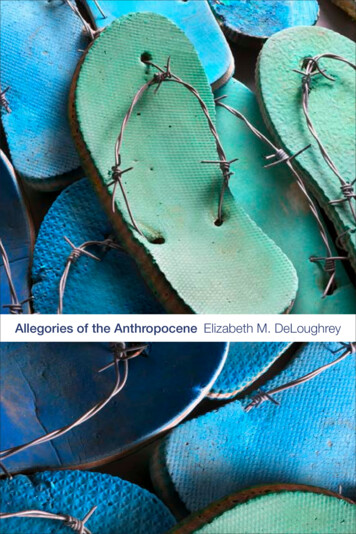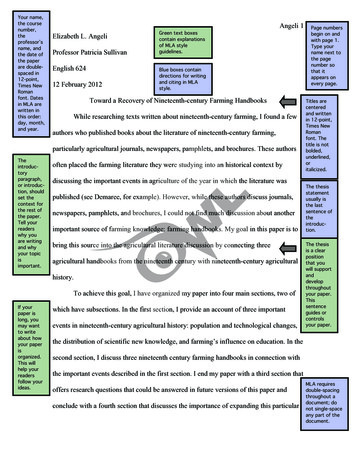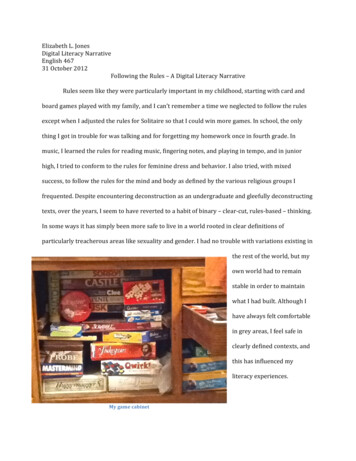
Transcription
Allegories of the Anthropocene Elizabeth M. DeLoughrey
Allegories of theAnthropocene
Elizabeth M. DeLoughreyAllegories of theAnthropoceneDuke University PressDurham and London2019
2019 Duke University PressAll rights reservedPrinted in the United States of Amer i ca on acid- free paper Designed by Courtney Leigh BakerTypeset in Garamond Premier Pro and Helvetica Neueby Westchester Publishing ServicesLibrary of Congress Cataloging-in-Publication DataNames: DeLoughrey, Elizabeth M., [date] author.Title: Allegories of the Anthropocene / Elizabeth M. DeLoughrey.Description: Durham : Duke University Press, 2019. Includes bibliographicalreferences and index.Identifiers: lccn 2018050151 (print)lccn 2019006483 (ebook)isbn 9781478005582 (ebook)isbn 9781478004103 (hardcover : alk. paper)isbn 9781478004714 (pbk. : alk. paper)Subjects: lcsh: Climatic changes—Effect of human beings on. Climatic changesin literature. Human ecology in art. Caribbean literature—21st century—Themes,motives. Pacific Island literature—21st century—Themes, motives. Art, Caribbean—21st century—Themes, motives. Art, Pacific Island—21st century—Themes, motives. Postcolonialism in literature. Postcolonialism and the arts. Climatic changes—Socialaspects—Caribbean Area. Climatic changes—Social aspects—Islands of the Pacific.Classification: lcc pn849.c3 (ebook) lcc pn849.c3 d44 2019 (print) ddc 809/.93355609729—dc23lc record available at https://lccn.loc.gov/2018050151Cover art: Tony Capellán, Mar Caribe (detail), 1995. Photo courtesy of Dennis Helmar.Author royalties from the sale of this book will be donated to the Refugee andImmigrant Center for Education and Legal Services (raices).This title is freely available in an open access edition thanks to the TOME initiativeand the generous support of Arcadia, a charitable fund of Lisbet Rausingand Peter Baldwin, and of the UCLA Library.
contentsvii1Acknowl edgmentsIntroduction: Allegories of the Anthropocene33one. Gendering Earth: Excavating Plantation Soil63two. Planetarity: Militarized Radiations98three. Accelerations: Globalization and States of Waste133four. Oceanic Futures: Interspecies Worldings165five. An Island Is a World197Notes257Index
Acknowl e dgmentsIn June 2010, I discovered that ten years’ worth of my research and notesfor a book proj ect on the cultural ecologies of transplantation w ere lost ina move and likely ended up in a Los Angeles landfill. The proj ect had beenpartially drafted; it was to be an examination of the vari ous ontologicalclaims to soil as created by exchange across the tropics of foods and commodities: breadfruit, coconut, sugarcane, and yam. The damage of that lossis prob ably significant to an overall claim in this book about an Anthropocene epoch that figures allegorical narratives of decline, fragmentation, andwaste and the possibilities of adaptation and growth. While that book waslost, a fragment, one root, remains in the opening chapter of Allegories of theAnthropocene.I have been fortunate to have a broad network of support in rebuildinga new book proj ect out of the ruins. This includes my colleagues at uclawho have read and commented on these chapters and to whom I give mymost heartfelt thanks: Victor Bascara, Judith Bettelheim, Keith Camacho,Chris Chism, Robin Derby, Helen Deutsch, Lowell Gallagher, LaurenHirshberg, Gil Hochberg, Rachel Lee, Françoise Lionnet, Jorge Marturano,Kathleen McHugh, Shu- mei Shih, and Jenny Sharpe. I have also learnedmuch from the intellectual engagement with my colleagues Andy Apter, AliBehdad, Judy Carney, Allison Carruth, Jessica Cattelino, Jon Christensen,Michelle Erai, Mishuana Goeman, Akhil Gupta, Sandra Harding, SusannaHecht, and Ursula Heise. My students have all contributed in many ways tomy thinking through ecological approaches to lit er a ture, arts, empire, andhistory. I wish to note in par tic u lar Nasia Anam, Kristen Cardon, LaurenDembowitz, Deb Donig, Yu- ting Huang, Dana Linda, Marilu Medrano,Alexei Nowak, Courtney Ryan, Joyce (Pua) Warren, and my research assistant
Sophia Lykke for our invigorating conversations about these texts and contexts in and out of the classroom, and on many dog walks.My sincere thanks to the following people for inviting me to share mywork— I benefited greatly from the encouragement to prepare new workand from some excellent feedback from my hosts and from the peoplegathered for each event: Godfrey Baldacchino and Eric Clark, coordinators ofthe International Geo graph i cal Union conference in Sven, Sweden; ByronCaminero- Santangelo, University of Kansas; Dipesh Chakrabarty, University of Chicago; Paulla Ebron, Stanford University; Sarah Fekadu, Ludwig- Maximilians- Universität, Munich; Paul Giles, Lisa Samuels, and BrendenO’Connor, coordinators of the Australia– New Zealand American Studies Association gathering at the University of Sydney; George Handley,Brigham Young University; Otto Heim, University of Hong Kong; HsinyaHuang, National Sun Yat- sen University and the Ocean and Island Ecol ogyResearch Network; Peter Hulme, University of Essex; Rosanne Kennedy,Australian National University; Yolanda Martínez- San Miguel and Michelle A. Stephens, Archipelagos Seminar, Rutgers University; Anne- MarieMc Manus, Nancy Reynolds and Vasiliki Touhouliotis, Washington University, St. Louis; Sean Metzger, Francisco- J. Hernández Adrian, and Michaeline Crichlow, Duke University; Martin Munro, Florida State University;Mike Niblett, University of Warwick; Viet Nguyen and Janet Hoskins,University of Southern California; Ineke Phaf, Humboldt University,Berlin; Hannah Boast and the Postcolonial Studies Association, University ofYork, UK; Ato Quayson, University of Toronto; Sangeeta Ray, Universityof Mary land, College Park; Johnny Riquet and Ana Sobral, University ofZu rich; Modhumita Roy, Tufts University; and Nicole Waligora- Davis andCary Wolfe, Rice University.The thinking about and writing of this book has also been made pos si ble by the generous support of fellowships and research grants. Specialthanks to Christof Mauch at the Rachel Carson Center for Environmentand Society (rcc) for his support of our workshop “Imperialism, Narrativeand the Environment” and to all of the workshop participants. It remainsto me one of the most impor tant gatherings for my thinking through therelationship between postcolonial studies and the environmental humanities. I was fortunate to have received an acls Frederick Burkhardt Residential Fellowship at the Huntington Library, which provided an invaluablebreak from my teaching and ser vice commitments at ucla. The UniversityviiiAcknowl edgments
of California Humanities Research Initiative Grant funded our “GlobalEcologies: Nature/Narrative/Neoliberalism” conference, and I extend mythanks to all of the presenters and participants at that event, which continued and expanded an invaluable discussion begun at the rcc. The University of California Pacific- Rim Grant, ucla International Institute FacultyResearch Award, and Burkle Center Faculty Research Grant supported mycolleagues Victor Bascara and Keith Camacho and me in organ izing workshops on militarization at home and at the University of the South Pacific,Fiji, which were integral to my research on radiation ecologies and to mylearning about comparative militarism in this book and beyond.In addition to the names already mentioned I have been buoyed by thefriendship, support, and intellectual engagements of Joni Adamson, BlakeAllmendinger, LeGrace Benson, Catherine Burwell, Ralph Crane, GauravDesai, Jill Didur, Germán Esparza, Esther Figueroa, Arianne Gaetano, AmyGriffiths, Graham Huggan, Peter Hulme, Anne Keala Kelly, Ilan Kelman,Jorge Marcone, Sarah Mattaliano, Dan Taulapapa McMillan, Radhika Mohanram, Susan Najita, Rob Nixon, Lisa Paravisini- Gebert, Crystal Parikh,Jon Pugh, Jenny Price, Karen Salt, Elaine Savory, Geoffrey Schramm,Malcolm Sen, Flavia Sparacino, Phil Steinberg, Nina Sylvanus, Thom VanDooren, Nicole Waligora- Davis, Linda Williams, Briar Wood, and Yetunde Zaid. As with my first book, Sangeeta Ray worked through manyideas with me and I am thankful for those years of unwavering mentorship.I also want to acknowledge Anitra Grisales for her editing support duringthe early drafts, and to the wonderful staff at Duke University Press for ushering this book through— particularly Courtney Berger, Sandra Korn, andChristopher Catanese.Most of all, I am indebted to my father, who came out to Los Angelesin August 2015 at a moment of crisis and saved my life. Recovering fromthat apocalyptic event was pos si ble only due to the love from my f amily andfriends, especially t hose who live in the heart of my home: Gregg, Pōtiki,Ray, and Luna.I dedicate this book to the living memory of four people who haveprofoundly influenced my thinking and who all passed away during theyears in which this book was written: the wonderful artist and dear friendTony Capellán, whose work graces the cover; my dear collaborator andfriend Anthony Carrigan; the visionary writer and my patient interlocutor, Wilson Harris; and fi nally, a vital demilitarism collaborator, TeresiaAcknowl edgmentsix
Teaiwa. Their work continues to sustain and inspire in the wake of lossand ruin.Portions of the book have been published in the journals Modern FictionStudies, Small Axe, Real: Research in En glish and American Lit er a ture, andin the volume Global Ecologies and the Environmental Humanities (2015).xAcknowl edgments
IntroductionAllegories of the Anthropocenetell them about the water— how we have seen it risingflooding across our cemeteriesgushing over the sea wallsand crashing against our homesTell them what it’s liketo see the entire ocean level with the land— K athy Jetñil- K ijiner, “Tell Them”Our increasing awareness of climate change is catalyzing new imaginaries and,by extension, new allegorical forms to address the dynamism of our planet.I open this book with the words of Kathy Jetñil- Kijiner, a per for mance poetfrom the Marshall Islands, who is prob ably the best- known figure to usepoetry in the ser vice of climate justice. She received a standing ovation at theUnited Nations Climate Summit in 2014 for her passionate testimony aboutthe impact of sea- level rise on the Pacific Islands and for a galvanizing poemabout the global climate future that she imagines for her infant daughter.1“Tell Them” poses a challenge to how we understand and represent the activerelationship between people and place. More specifically, the poem employsallegory to figure the island as a world in ecological crisis, depicts an active,nonhuman ocean agent, and articulates the imperative to both witness andtestify to a dynamic, changing Earth. All three of these allegorical tropes arevital to this book’s exploration of the relationship between the Anthropoceneand empire in an era of accelerating environmental catastrophe.
The rapid increase in atmospheric carbon; extreme weather events suchas drought, flooding, fire, and hurricanes; cataclysmic species extinctions;sea- level rise; ocean acidification; and a warming planet all testify to a crisisof global climate change known as the Anthropocene. This is a twenty- first- century term that some scholars use to signal that human activity hasattained the scale of a geological force akin to a volcanic eruption or a meteorite, changing the Earth as a system.2 While there has been a virtual cottageindustry of new journals and publications exploring the Anthropocene inrecent years, the conversation has been dominated by the geophysical andsocial sciences, which tend to privilege positivist methods and have littleto say about the vitality of the arts and humanities. Scholarship that doesturn to the role of the Anthropocene cultural imaginary is focused almostexclusively on the viewpoints of the global north. This body of work hastended to favor literary forms such as the novel and white (settler) culturalproduction from the United States, Australia, and Eu rope.The lack of engagement with postcolonial and Indigenous perspectiveshas shaped Anthropocene discourse to claim the novelty of crisis ratherthan being attentive to the historical continuity of dispossession and disastercaused by empire. In this sense Anthropocene scholarship produces a globalization discourse that misses the globe. Thus its cultural geographies andmethods are still insufficient to address a complex crisis of planetary scale.This book argues that in an era of a truly global environmental crisis, Anthropocene scholarship cannot afford to overlook narratives from the globalsouth, particularly from t hose island regions that have been and continue tobe at the forefront of ecologically devastating climate change.Due to their enormous scales and their discursive histories, the figuresof nonhuman nature, the human, Earth, and now the Anthropocene sharea universalizing geologic. Allegories of the Anthropocene stages an interdisciplinary dialogue between the (social) sciences and the humanities, withpar tic u lar attention to how the universalizing figure of the Anthropocenemight be grounded by engaging specific places such as postcolonial islands.This demands a multiscalar method of telescoping between space (planet)and place (island) in a dialectic or “tidalectic” way to see how they mutuallyinform each other.3 Bringing together the work of postcolonial, Indigenous, and Anthropocene discourses, I argue that we must “provincialize”the Anthropocene, much as postcolonial studies “provincialized” the universalizing discourse of Eu rope, to borrow from Dipesh Chakrabarty.4 This isnot a casual analogue: the “universal and secular vision of the human” that2 introduction
Chakrabarty sought to decenter in Eu ro pean discourse has been regeneratedin much Anthropocene scholarship of the “Age of Man,” resurrecting a figure who reigns as a singular (masculine) “species.”5 Both of t hese discoursesare inextricably tied to histories and discourses of empire— particularly, as Iargue here, through the use of narratives of disjunction and rupture.Turning to lit er a ture, film, and the arts, this book asks: what kinds ofnarratives help us navigate an ecological crisis that is understood as localand planetary, as historical and anticipatory? Questions about narrative andrepre sen ta tion are vital to understanding the Anthropocene because, as anepoch that reflects a radical break from the past, it poses specific epistemological and ontological challenges, which Chakrabarty has been the first toarticulate.6 Of course, the Anthropocene is material in that it concerns whatcan be mea sured and experienced, and it is repre sen ta tional in that it raisesvital questions as to how the planet as a system can be signified. While a cacophony of voices are theorizing the Anthropocene, most argue that it reflectsa moment of disjunction and rupture in geological history and perhaps inknowledge-making itself.7 Of course, this discourse of rupture is deeply familiar to postcolonial and Indigenous studies in its theorization of the “irruptioninto modernity” that characterizes the ongoing experience of empire.8The primary rupture in knowledge constitutive to the Anthropoceneis that our experience of local weather is not commensurate with understandings of global climate. In other words, due to the difficulty of Earthsystems modeling, Hurricane Maria— which pummeled the Ca rib bean in2017— cannot, on its own, provide evidence of global climate change.9 Thisbreak between the local experience of extreme weather and its abstractionat a global scale is evident in the concluding lines of Jetñil- Kijiner’s poem:tell themwe are afraidtell them we don’t knowof the politicsor the sciencebut tell them we seewhat is in our own backyard. . . . . . . . . .But most importantly you tell themwe don’t want to leave we’ve never wanted to leave Allegories of the Anthropocene3
and that wearenothingwithout our islands.10This claim that “we don’t know”—in a poem that declares the audience must“tell them”—is an in ter est ing choice by the author, signaling a rift in knowledge production and circulation. Marshallese diplomats have been some ofthe most influential figures at e very climate change summit and have galvanized a critical bloc of postcolonial island states to help to lower the targetedtwo- degree limit of global temperature increase. Some have even likened themajor carbon emitters to contributing to cultural genocide.11 Yet here thepoet deliberately minimizes their historical participation in the arena ofpolitics and science to bring forward an allegorical disjuncture between theexperience of place (“we see/what is in our own backyard”) and the abstractrealm that “we d on’t know” (the politics and science). While theorists havecalled attention to the challenges posed by this break between experienceand knowledge, Jetñil- Kijiner’s poem allegorizes Marshallese experience tomake a claim for a cultural geologic that is not reducible to a universalizedclimate science of the Anthropocene. As such, culture, climate, experience,knowledge, and the Anthropocene are all placed in disjunctive relation. Yet these ruptures and disjunctions in narrative and in knowledge do not collapse neatly into one another. Moreover, the repeated imperative to “tellthem” enlists allegory’s pedagogical incentives and its incitement to action.12This book claims that allegory has been revitalized and reinvented to represent this perceived disjunction between humans and the planet, betweenour “species” and a dynamic external “nature.” This is a spatial as well astemporal rupture. Engaging with the Anthropocene means that we mustsi mul ta neously consider the deep geological time of the planet—in comparison with previous epochs—as well as the futurity of the human as aspecies.13 Futurity is marked not just by concerns about h uman survival, orameliorating species extinctions, but also by the fact that one cannot locate astratigraphic marker for this epoch until a geologically significant period oftime— such as tens of thousands of years— has passed.14 Thus, the Anthropocene is both forward- looking and a future retrospective, characterized by“anticipatory logics” and anticipatory mourning.15 The Anthropocene epochis constituted by a deep geological sense of the longue durée, as well as dis4 introduction
junctive spatial relations between the enormity of the planet and the experience of local place. Due to its ability to represent both historical and scalarrelations, allegory has arisen as a notable form for this moment of planetaryclimate crisis. Perhaps this is not surprising b ecause allegory is known for itsembeddedness in history (time), its construction of a world system (space),and its signification practices in which the par tic u lar figures for the generaland the local for the global.In fact, environmental discourse is rife with allegorical modes. For example,the popu lar rallying cry “Save the Planet” employs a metonymic or substitutivecomponent of allegory in which “Planet” stands in for a par tic u lar species— most notably, the h uman. The synecdochical, or part- for- whole, function ofallegory is evident in claims that we are in an era of “anthropogenic” climatechange when the crisis actually derives from the activities of a power ful minority of human beings.16 Following Sylvia Wynter’s postcolonial critique,we know that a par tic u lar bourgeois “ethnoclass” that calls itself Man “over- represents itself as if it were human.”17 Yet, as Joni Adamson and other haveargued from Indigenous, postcolonial, and feminist perspectives, “we havenever been Anthropos.”18 Allegory is more than the use of rhetorical tropes. Itis the animation of universalizing figures such as planet, species, nature, and the human into narrative— and thereby into space and time.Concurrent with the recent Anthropocene turn, there has been a risein allegorical repre sen ta tion in lit er a ture, film, and visual arts. Allegorystages other worlds to draw parallels and disjunctions between the pre sentand an often dystopic f uture. This is particularly evident in the spike in climate apocalypse films that employ allegory, such as The Day after Tomorrowand 2012 (Roland Emmerich), Noah (Darren Aronofsky), and Snowpiercer(Bong Joon-ho), to name only a few. This uptick is attributable to the factthat allegory appears in moments of acute historical crisis, as Walter Benja min has demonstrated. In his reading, modern allegory triggered a new relationship with nonhuman nature that recognized it as a historical ratherthan an abstract ideal. When modern allegory engages nature as history(what Benja min termed “nature- history”), then history becomes subject tonature and therefore to decline.19 Western philosophy assumes a split between non human nature and history that other epistemologies do not accept. Benjamin’s dialectical engagement with nature, history, and allegorydemarcated a radical shift from a universalized nature to its parochialization. Thus the split noted by many Anthropocene scholars who are workingin the context of western philosophical traditions had already been theorized Allegories of the Anthropocene5
by Benjamin. Analy sis of narrative is one of the impor tant labors of the environmental humanities. Thus engaging the work of allegory— particularlythe allegoresis of nature- history— opens the possibility of reading the manystories of climate change and the Anthropocene.20We can see how Benjamin has laid the groundwork for theorizingAnthropocene discourse in that the latter also remarks on a disjuncturebetween humans (history) and the planet (nature) while suggesting bothare anticipated to decline. Decline is represented in Benjaminian allegoryand Anthropocene scholarship as ruins. In the Anthropocene context thisis quite literal, as our reading of geological epochs is dependent on the legibility of fossils and radiocarbon decay. As such, both produce allegoricalspeculations on the f uture as ruins. The recognition of this seemingly newdisjunctive relationship between the h uman and the planetary environmentrepresents a crisis of ecological modernity in which allegory appears as oneof its primary narrative rec ords. This is the central argument of Allegories ofthe Anthropocene.In an age of thinking about the totality of the planet, it is significant thatof all modes, allegory is best known for constructing a model of the world orcosmos. As Bruce Clarke has argued, “Allegory typically models a conceptof world- space through an articulation of nested structures, universal systems with a montage of ontological levels.”21 These worlds are always separate from the reader/viewer, figured as necessarily disjunctive due to theirutopian, dystopian, or perhaps subaltern difference from the audience. Thisis why the trope of the isolated island has been such a power ful constellationfor thinking allegorically. From an early Arabic novel, Hayy ibn Yaqdhan, toEn glish lit er a ture classics such as Utopia, Robinson Crusoe, and Lord of theFlies, allegory has long relied on the figure of the island to engage the scalartelescoping between local and global, island and Earth. The island’s simultaneous boundedness and its permeability to travelers— and therefore its susceptibility to radical change— have made it a useful analogue for the globeas a whole.22 Of course, the island also represents finitude, a cautionaryconcept for the Anthropocene epoch of planetary bound aries that includethreats to biodiversity and mass extinctions.23 This part- for- whole analogyis discernible in island extinction stories, such as the history of the dodo ofMauritius, the ecological cautionary tales of Rapa Nui (Easter Island), and,more recently, the example of the Marshall Islands.The island has long been a figure for radical “climate change,” a termI use h ere as it is more generally understood as an upheaval of an ecologi6 introduction
cal system. In keeping with work in feminist, postcolonial, and Indigenousstudies that does not bifurcate nature and culture, the concept of ecol ogyas it is used h ere always includes the h uman. Thus, I turn to con temporarypostcolonial island texts and contexts as a means of allegorizing the Anthropocene, arguing that it is vital to bring the theoretical discourse of the globalnorth into dialogue with communities that both are at the forefront of pre sent climate change and its historical survivors. In grounding the abstractdiscourse of the Anthropocene by tying it to specific histories and places wecan learn much about the contextual nuances of narrativizing the relationship between human and more- than- human nature. Moreover, we mighthistoricize a long history of rupture in small- scale climate systems such asislands. Of course, the galvanizing tendency of allegory to elicit action mayalso help to produce more effective modes of bringing about ecological andpo liti cal change.Some may rightly question whether the claim of Anthropocene discourse that we have an entirely new ecological crisis is, in fact, belated.Turning to Indigenous and postcolonial island writers and artists, we cansee that catastrophic ruptures to social and ecological systems have already been experienced through the violent pro cesses of empire. In otherwords, the apocalypse has already happened; it continues b ecause empireis a pro cess.24 For writers and artists engaging the history of plantationslavery or nuclearization, the apocalyptic or declensionist narrative ofthe Anthropocene is not only a future anticipation of the “end of nature” but also a remembrance of a violent historical past with ongoingrepercussions for the pre sent.25 As Heather Davis and Zoe Todd observe,“the Anthropocene—or at least all of the anxiety produced around theserealities for t hose in Euro- western contexts—is really the arrival of thereverberations of that seismic shockwave into the nations who introducedcolonial, cap i tal ist pro cesses across the globe in the last half- millenniumin the first place.”26Thus, my definition of “climate change” throughout this book refers to aworld- changing rupture in a social and ecological system that might be readas colonization in one context or sea- level rise in another. While many of thetexts examined here could be categorized u nder the popu lar neologism “cli-fi”(climate fiction, or climate film), they engage climate in ways that deepenour geographic and historical understandings of adaptation and re sis tanceto world- shattering change. These works often revitalize and reformulate allegorical modes that are integral to mitigating our ecological f utures. In an Allegories of the Anthropocene7
era of crisis about our “Earth Island,” island writers and artists provide aprescient perspective about the part’s relationship to the whole.A humanities- based approach to the concept of the Anthropocene callsattention to the ways in which stories are told and to how crises are narratedor visualized. Allegory is a form that is particularly noted for how it stagesthe pre sent’s relationship to the past; this is often articulated in terms ofan engagement with tradition and a search for origins. A flurry of debateshas arisen in the past few years alone about to how to pinpoint the stratigraphic (sedimentary) origin of the Anthropocene, generally understoodas a moment when (some) humans exceeded their “natu ral” limits andbound aries— what Anna Tsing terms “inflection points”— and impacted theplanet’s geology in ways that will leave isotopic traces for millennia.27 Theseare narratives of a rupture in the h uman relationship to the planet, a wayof reckoning ecological modernity. Kathryn Yusoff has called attention toa heightening of “anthropogenesis” narratives of the Anthropocene, storiesthat are as much about beginnings as they are about an “ imagined ending” forthe human.28 To date, many anthropogenesis narratives are being proposed,without any consensus or attempt to link them in a chronology. Pos si blemarkers include the global rise of agriculture thousands of years ago; transatlantic Eu ro pean colonization, genocide, and ecological imperialism; therise of capitalism, industrial modernity, and its legacies of fossil fuel; theradioactive isotopes from Cold War nuclear testing; and the “ Great Acceleration,” a term for the advent of globalization, in which expansion of agribusiness, urbanization, manufacturing, technology, and waste are now partof the planetary fossil rec ord.29I or ga nize this book around t hese moments of rupture, of perceivedturning points in the h uman relationship to the planet, following Benjamin’s work on the “flash” of understanding in which “thought comes to astandstill in a constellation saturated with tensions.”30 These constellationsof the Anthropocene are thought to signal planetary turning points andshape the structure of this book. Allegories of the Anthropocene engages literary and visual cultures of the Ca rib bean and Pacific Islands through fiveconstellations that are thought to e ither originate or encapsulate globalclimate change: the plantation (agriculture); radiation (militarism); waste(globalization); ocean (sea- level rise); and island (world). While I engagewith anthropogenesis narratives, I am not interested in fixing an origin forthe Anthropocene or in posing a chronology. Postcolonial studies has longcriticized the unilinear narratives of pro gress that are constitutive to em8 introduction
pire, and substituting one homogenizing telos with a narrative of declinestill takes a model of “single, homogenous, and secular historical time forgranted.”31 Instead, I adopt an allegorical frame of engaging constellationsin which “paradox has the last word,” to paraphrase Benjamin. Drawingfrom the work of Benjamin and Indigenous and postcoloni
hanram, Susan Najita, Rob Nixon, Lisa Paravisini-Gebert, Crystal Parikh, Jon Pugh, Jenny Price, Karen Salt, Elaine Savory, Geoffrey Schramm, Malcolm Sen, Flavia Sparacino, Phil Steinberg, Nina Sylvanus, Thom Van Dooren, Nicole Waligora-Davis, Linda Williams, Briar Wood, and Ye-tunde Zaid











